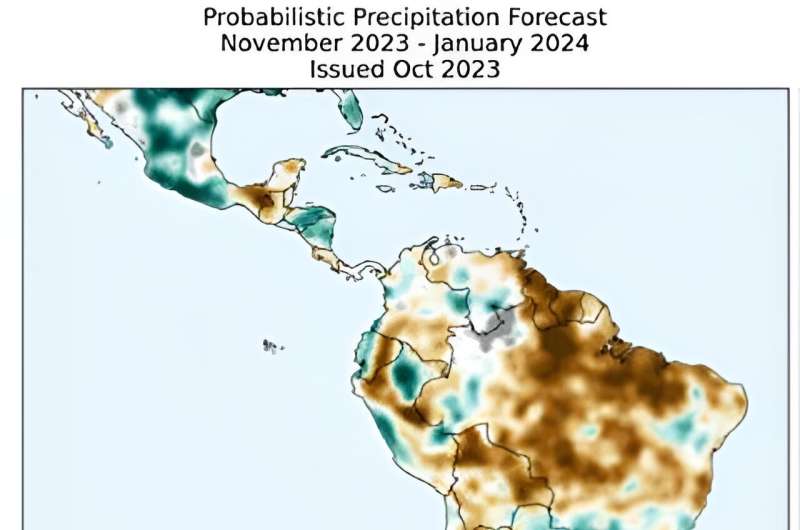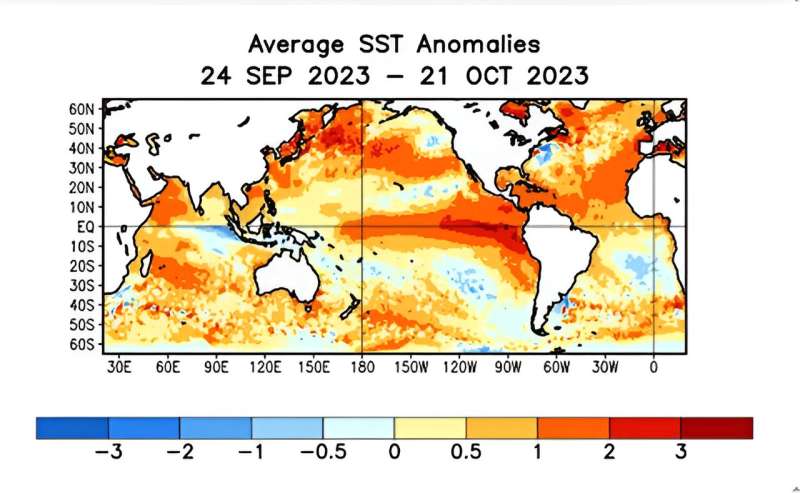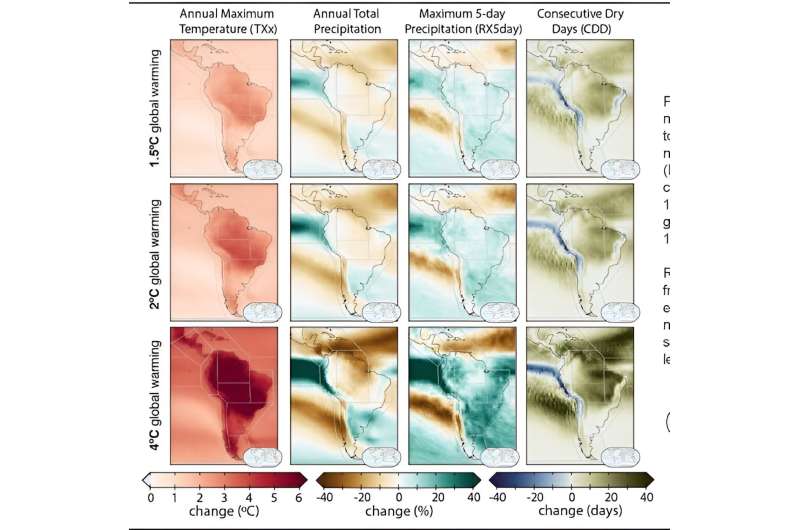This article has been reviewed according to Science X's editorial process and policies. Editors have highlighted the following attributes while ensuring the content's credibility:
fact-checked
trusted source
written by researcher(s)
proofread
Amazon region hit by trio of droughts in grim snapshot of the century to come

The Amazon is facing an unprecedented drought that is projected to continue affecting the region at least until mid-2024. The lowest water levels in 121 years of river-level records have been recorded in the city of Manaus. Vast areas of the Amazon River's bed have been exposed, and more than 150 dolphins died in a lake where water temperatures reached 39°C (2°C above human body temperature). Human populations along Amazonian rivers have been isolated, stripped of their livelihoods and lack basic necessities.
This year has brought three kinds of drought simultaneously, resulting in practically the entire Amazon region being affected. The forecast for November 2023 through January 2024 is for drought across almost the whole region. Some projected rain in Peru may help with water levels in the Amazon River, but the wider region remains exposed to drought stress and forest fires.
The eastern El Niño
There is an eastern El Niño caused by warm water in the eastern part of the equatorial Pacific Ocean, as occurred during the "Godzilla" El Niño of 2015, and the water there is even hotter than it was in 2015. The 250-km/hour winds of Hurricane Otis that devastated Acapulco are testament to the strength of warming in the eastern Pacific.
In addition to drought in the northern Amazon, the effects of an eastern El Niño extend to the southern part of the region, as was evident during the 2015-2016 forest fires in Brazil's state of Acre and is now reflected by record low water levels in the Amazon tributaries from the southern part of the basin, including the Madeira River where electricity generation had to be completely halted at Brazil's fourth largest hydropower plant, the Santo Antônio Dam.
The central El Niño
The hot water in the eastern Pacific is now expanding to the central part of the ocean, where it provokes a central El Niño as occurred in 1982 and 1997. A central El Niño results in an intense drought in the northern Amazon, with the state of Roraima on Brazil's border with Venezuela being the most famous for forest fires. The "great Roraima fire" in 1997 burned around 1.25 million hectares of forest.
The 1982 El Niño, in addition to killing trees in the Amazon, killed more than 200,000 people in Ethiopia and neighboring African countries through drought. The 1995 report of the Intergovernmental Panel on Climate Change (IPCC) indicated that something had changed in the global climate system making El Niños more frequent since 1975. The 2007 IPCC report it became official that global warming will cause more frequent "El Niño-like conditions."
This completely changes the political and moral context of these events because global warming is increasing due to human actions, and the responsibility of each country and even of each individual can be quantified. The probability of the water in the central Pacific Ocean returning to a "normal" temperature is projected to be essentially zero until January-March 2024, and to not reach 50% until May-July 2024.

The Atlantic dipole
The third type of drought hitting the Amazon is from an "Atlantic dipole," where a patch of warm water forms in the tropical North Atlantic Ocean while there is colder water in the South Atlantic. An Atlantic dipole causes drought in the southwestern part of the Amazon, as happened in 2005 and 2010. The forest fires in Acre in 2005 and 2010 are testament to the power of the Atlantic dipole. The present Atlantic dipole is projected to last until at least June 2024.
Climate forecast for the Amazon until 2100
The projections for changes in Amazonia's climate by the year 2100 are truly catastrophic. Many of today's children will live to see it. Global mean temperature has so far increased by 1.2 °C since the beginning of the industrial revolution in 1750, and the impacts of this are already apparent around the world, including in Amazonia.
If all countries fulfill their commitments, such as those under the Paris Agreement, the global mean temperature would increase to around 2.7 ±1 °C above the preindustrial mean by 2100. However, if emissions continue to increase following the current Intergovernmental Panel on Climate Change (IPCC) "shared socioeconomic pathways" (SSPs), it would reach more than 4 °C.
These projections only consider intentional human-caused emissions—unintentional emissions, such as forest fires and soil warming, are likely to increase as well, and if a tipping point is reached and unintentional emissions explode outside of human control, the situation would be far worse. History does not end in 2100, and temperatures will continue to rise.
Average global temperature increases are always lower than increases in a place like the Amazon because 70% of the planet is covered by water, and air temperature increases are smaller over oceans than over continents. The potential 4 °C increase in the global average implies an increase of the maximums by more than 6 °C throughout the Amazon. At the same time, water will be lacking with the number of consecutive days with rain per year increasing by up to 40 days or more.
It should also be remembered that the averages are always much smaller than the maximums, especially during extreme events. Therefore, changes by 2100 could cause the loss of the Amazon forest even if the averages were controlled to levels such as 2°C, much lower than those with high emissions. The forest would be degraded by impacts such as the death of standing trees due to exceeding their temperature and water stress tolerance limits.
When temperatures rise, any plant needs more water just to survive, and this water will not be available during more intense and longer droughts. Amazonian forests varied greatly in their sensitivity to the water stress caused by the 2015 El Niño, being more sensitive in the northwestern part of the region.
South American tropical forests lost at least 820 million tons of carbon during the 2015 El Niño, not counting wildfires. Forest fires are more frequent and larger in dry and hot conditions and are also being driven by the impact of logging, both legal and illegal, which is rapidly spreading in the region.

The Amazon rainforest has enormous stores of carbon in the trees and in the soil. Unlike the emission of carbon in the form of greenhouse gases from one year to the next, this carbon stock represents a latent bomb that can explode without being intentional.
The latest report from the Intergovernmental Panel on Climate Change (IPCC) indicates that all human activity (mainly fossil fuels and deforestation) releases 12 billion tons of carbon per year. This means that global warming would escape human control if more than 12 billion tons of additional carbon were emitted per year by unintentional changes, such as forests burning, tundra melting, the world's soils warming, and the oceans warming and reducing their absorption of CO2.
The Amazon is at the center of this problem. Based on estimates in the Brazilian Amazon, the Pan-Amazon region as a whole has approximately 80 billion tons of carbon in vegetation and 90 billion in the first meter of soil, plus roughly 250 billion in soil between one and eight metres deep that would be released more slowly. Just a fraction of this carbon being released over the space of a few years, say, as forests die from droughts and fires, would be the last straw in pushing the global climate past a tipping point.
What needs to be done?
First, there is no alternative to the entire world drastically cutting greenhouse gas emissions beginning immediately. To avoid passing the 1.5°C threshold that greatly increases risk of passing tipping points both for global climate and for maintaining Amazon forest, global emissions must be cut by 43% by 2030 and 84% by 2050 according to the latest results of the Climate Convention's "stocktake."
In the case of Brazil, both fossil fuel emissions and deforestation must be contained, and the country is largely on the wrong path in both areas. For fossil fuels, the Brazilian government is pressing to open new oil and gas fields in the estuary of the Amazon River, in coastal waters of northeastern Brazil, and in the Amazon forest.
For deforestation, although Brazil's Ministry of the Environment and Climate Change, under the presidential administration that took office in January 2023 has excellent leadership and is making heroic efforts to repress illegal deforestation, the rest of the government is pushing in the opposite direction. But the necessary task of inspecting and fining those who violate environmental regulations is not enough: political courage must be mustered to face the forces underlying deforestation.
One cannot continue to promote projects that drive deforestation and expect that the environment ministry will contain the consequences. These projects include new roads that open vast areas of the remaining forest in Amazonia to the entry of deforesters, the most immediate issue being the proposed "reconstruction" of Highway BR-319 connecting a notorious "arc of deforestation" in southern Amazonia to relatively intact central Amazonia, with additional roads that would open the vast forest areas in the western part of Brazilian Amazonia.
Equally essential is ending the continued legalization of land claims in government land, which drives an unending sequence of land invasions and online "landgrabbing" that is greatly facilitated by the Rural Environmental Registry (CAR) established by Brazil's 2012 Forest Code. Despite discourse on controlling deforestation, the current plans and policies lead in the opposite direction for both roads and legalization of land claims.
Provided by The Conversation
This article is republished from The Conversation under a Creative Commons license. Read the original article.![]()




















